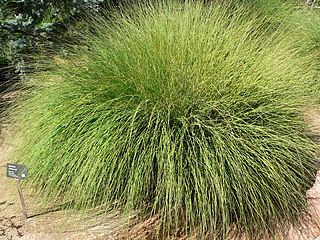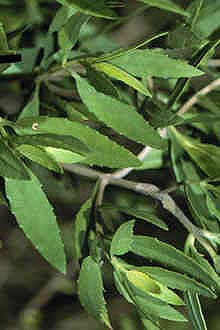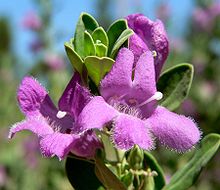
Prosopis is a genus of flowering plants in the family Fabaceae. It contains around 45 species of spiny trees and shrubs found in subtropical and tropical regions of the Americas, Africa, Western Asia, and South Asia. They often thrive in arid soil and are resistant to drought, on occasion developing extremely deep root systems. Their wood is usually hard, dense and durable. Their fruits are pods and may contain large amounts of sugar. The generic name means "burdock" in late Latin and originated in the Greek language.
Sage or SAGE may refer to:

Calliandra is a genus of flowering plants in the pea family, Fabaceae, in the mimosoid clade of the subfamily Caesalpinioideae. It contains about 140 species that are native to tropical and subtropical regions of the Americas.

Fagonia is a genus of wild, flowering plants in the caltrop family, Zygophyllaceae, having about 34 species. The latest reorganization of the genus took place in 2021 when systematists Christenhusz & Byng included Fagonia spp.. along with several other Zygophyllum genera, into a new genus named "Zygophyllum L." Species occurring in the US are commonly referred to as fagonbushes. The distribution of the genus includes parts of Africa, the Mediterranean Basin, the Mid-East, India, and parts of the Americas. Fagonia species have been used ethnobotanically by traditional practitioners under Ayurvedic and other TM healing regimes for many maladies. Species occur in deserts, dry washes, ditches and on rocky outcrops, including at altitude.

Dichondra is a small genus of flowering plants in the morning glory family, Convolvulaceae. They are prostrate, perennial, herbaceous plants, with creeping stems which take root readily at the leaf nodes. The flowers are white, greenish or yellowish, 2–3 mm diameter. Members of the genus are commonly known as ponysfoots and are native to tropical and cool temperate regions around the world.

Purple sage has various uses, mostly referring to plants or to Zane Grey's novel Riders of the Purple Sage, set in Utah. There is disagreement about what plant Grey had in mind.

Colubrina is a genus of about 30 species of flowering plants in the family Rhamnaceae, native to warm temperate to tropical regions of Africa, the Americas, southern Asia, northern Australia, and the Indian Ocean islands.

Cephalanthus is a genus of flowering plants in the family Rubiaceae. There are about six species that are commonly known as buttonbush.

Iresine is a genus of flowering plants in the family Amaranthaceae. It contains 20 to 25 species, all of which are native to the American tropics. The generic name is derived from the Greek word εριος (erios), meaning "wooly", referring to the trichome-covered flowers. Bloodleaf is a common name for those species that have colored foliage, and these are often cultivated as ornamental plants. Some species are additives to versions of the hallucinogenic drink ayahuasca.

Ericameria nauseosa, commonly known as Chamisa, rubber rabbitbrush, and gray rabbitbrush, is a shrub in the sunflower family (Aster) found in the arid regions of western North America.

Leucophyllum frutescens is an evergreen shrub in the figwort family, Scrophulariaceae, native to the U.S. state of Texas, where it is the official "State Native Shrub of Texas", and to the states of Coahuila, Nuevo León, and Tamaulipas in northern Mexico. Although commonly known as Texas sage, it is not a true sage and is distinct from the genus Salvia. The species is also called Texas Ranger, Texas rain sage, cenizo, Texas silverleaf, Texas barometerbush, ash-bush, wild lilac, purple sage, senisa, cenicilla, palo cenizo, or hierba del cenizo.

Muhlenbergia is a genus of plants in the grass family.

Espeletia, commonly known as 'frailejones', is a genus of perennial subshrubs, in the family Asteraceae. The genus, which is native mainly to Colombia, Venezuela and Ecuador, was first formally described in 1808. The genus was named after the viceroy of New Granada, José Manuel de Ezpeleta.
Thymophylla tephroleuca is a rare species of flowering plant known by the common names ashy pricklyleaf and ashy dogweed. It is endemic to Texas in the United States, where it occurs in two counties near the Mexican border. It became rare due to the destruction and degradation of its habitat. It is a federally listed endangered species of the United States.
Retiniphyllum is a genus of flowering plants in the family Rubiaceae and contains 20 species. It is the only genus in the tribe Retiniphylleae. The representatives are shrubs or small trees that grow in white sand soils in tropical South America. They are mainly distributed in the Guayana Region (Venezuela) but also occur in the Amazon Basin, the eastern Andes and central and eastern Brasil.

Iva frutescens is a species of flowering plant in the family Asteraceae known by the common names Jesuit's bark, bigleaf marsh-elder, and high-tide bush. It grows in coastal eastern North America from Nova Scotia down the eastern coast and along the Gulf Coast to Texas.
Symphoricarpos microphyllus, the pink snowberry, is a North American species of flowering plant in the honeysuckle family. It is widespread across much of Mexico from Chihuahua to Chiapas, and found also in Guatemala, Honduras, and the US State of New Mexico.
Antiphytum, commonly known as saucerflower, is a genus of flowering plants belonging to the family Boraginaceae.

Leucophyllum zygophyllum, the blue ranger or blue rain sage, is a species of flowering plant in the family Scrophulariaceae, native to northeastern Mexico. A shrub with attractive opposite foliage and a habit of flowering before rainstorms, it is recommended for xeriscaping. It is highly heat and drought tolerant, and is cold hardy to USDA zone 8a. There is a cultivar, 'Cimarron', which is somewhat dwarfed, reaching 3 ft (1 m).














